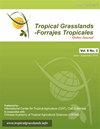埃塞俄比亚法塔羊生长饲粮中混合Mulato II与天然牧草的组合
IF 0.7
4区 农林科学
Q3 AGRICULTURE, DAIRY & ANIMAL SCIENCE
引用次数: 2
摘要
本试验研究了在基础饲粮中添加不同比例的地方精料混合物(CM)的法塔羊羔羊的采食量、消化率、体重变化和胴体特性。选取25只平均初始体重为19.6±0.29 kg(平均±s.e)的1龄法塔公羔羊,分别进行饲喂(90 d)和消化率(7 d)试验。试验羔羊按体重分层随机分为5个饲粮处理:100%天然牧草干草(NPH) (T1);75% NPH+25% Urochloa杂交Mulato II干草(MH) (T2);50% nph +50% mh (t3);25% nph +75% mh (t4);100% MH (T5)。饲喂局部浓缩混合物[300 g干物质/hd/d]。基础饲粮粗蛋白质(CP)浓度随着MH在日粮中所占比例的增加而升高(P<0.05)。随着粗料中MH比例的增加,干物质和营养物质的采食量及营养物质消化率系数显著增加(P<0.05)。随着基础饲粮中MH的添加比例从0增加到100%,末重、平均日增重、饲料转化效率和大部分胴体参数均显著(P<0.05)提高。从试验羔羊的生物学性能来看,饲粮中添加MH可显著提高该地区绵羊的生产性能。经济评估将揭示原生牧草和MH的最佳组合,以实现特定的结果。其他改良的禾本科和豆科植物也可以发挥同样的作用,应该在不同的环境中进行研究。本文章由计算机程序翻译,如有差异,请以英文原文为准。
Combinations of Urochloa hybrid Mulato II and natural pasture hays as a basal diet for growing Farta lambs in Ethiopia
The study was conducted to evaluate the feed intake, digestibility, bodyweight change and carcass characteristics of Farta lambs fed Brachiaria (now: Urochloa) hybrid Mulato II and natural pasture hays in various proportions as a basal diet supplemented with a local concentrate mixture (CM). Twenty-five yearling male Farta lambs with a mean initial body weight of 19.6±0.29 kg (mean±s.e.) were used in feeding (90 days) and digestibility (7 days) trials. The lambs were randomly allocated to the following 5 dietary treatments on the basis of stratified body weight: 100% natural pasture hay (NPH) (T1); 75% NPH+25% Urochloa hybrid Mulato II hay (MH) (T2); 50% NPH+50% MH (T3); 25% NPH+75% MH (T4); and 100% MH (T5). A local concentrate mixture [300 g dry matter (DM)/hd/d] was fed to all animals. Crude protein (CP) concentration of the basal diet increased as proportion of MH in the ration increased (P<0.05). Intake of DM and nutrients, and nutrient digestibility coefficients increased significantly (P<0.05) as proportion of MH in the roughage component of the ration increased. Final body weight, average daily bodyweight gain, feed conversion efficiency and most carcass parameters measured were significantly (P<0.05) higher as proportion of MH increased from 0 to 100% in the basal diet. Based on the biological performance of the experimental lambs, performance of sheep in the region could be enhanced significantly by incorporating MH with native pasture hay and concentrate supplement in feeding rations. Economic assessments would reveal the optimal combinations of native pasture and MH for feeding to achieve particular outcomes. Other improved grass and legume species may fill the same role and should be investigated in differing environments.
求助全文
通过发布文献求助,成功后即可免费获取论文全文。
去求助
来源期刊

Tropical Grasslands-Forrajes Tropicales
Agricultural and Biological Sciences-Agronomy and Crop Science
CiteScore
1.60
自引率
0.00%
发文量
36
审稿时长
16 weeks
期刊介绍:
The Journal publishes, in English or Spanish, Research Papers and Short Communications on research and development, as well as contributions from practitioners (Farmer Contributions) and Review Articles, related to pastures and forages in the tropics and subtropics. There is no regional focus; the information published should be of interest to a wide readership, encomprising researchers, academics, students, technicians, development workers and farmers.
In general, the focus of the Journal is more on sown (''improved'') pastures and forages than on rangeland-specific aspects of natural grasslands, but exceptions are possible (e.g. when a submission is relevant for a particularly broad readership in the pasture and forage science community).
The Journal will also consider the occasional publication of associated, but closely related, research in the form of an additional scientific communication platform [e.g. a re-make of the former Genetic Resources Communication series of the former Division of Tropical Crops and Pastures of the Commonwealth Scientific and Industrial Research Organisation (CSIRO), Australia].
Areas of particular interest to the Journal are:
Forage Genetic Resources and Livestock Production[...]
Environmental Functions of Forages[...]
Socio-economic Aspects[...]
Topics within the aforementioned areas may include: Diversity evaluation; Agronomy; Establishment (including fertilization); Management and utilization; Animal production; Nutritive value; Biotic stresses (pests and diseases, weeds); Abiotic stresses (soil fertility, water, temperature); Genetics and breeding; Biogeography and germplasm collections; Seed production; Ecology; Physiology; Rhizobiology (including BNF, BNI, mycorrhizae); Forage conservation; Economics; Multilocational experimentation; Modelling.
 求助内容:
求助内容: 应助结果提醒方式:
应助结果提醒方式:


